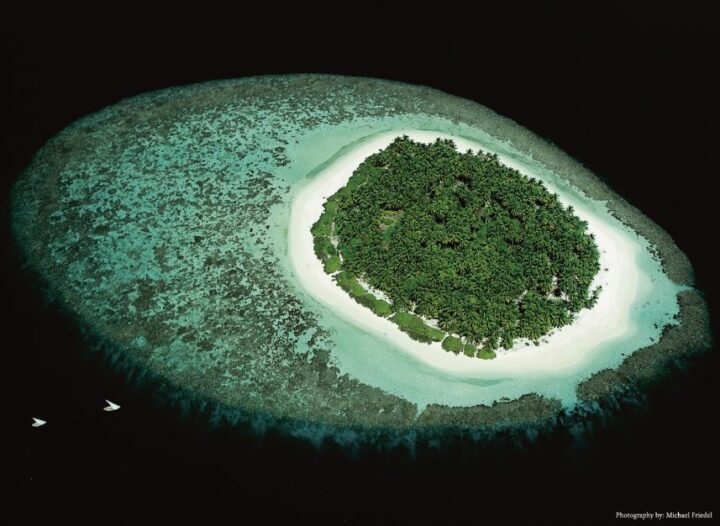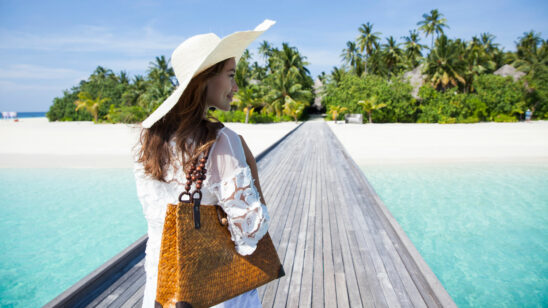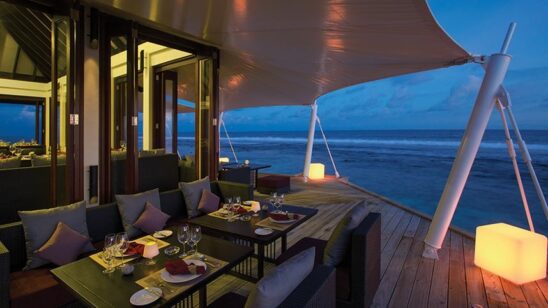
A journey through time, with industry pioneer Ahmed Adam
[vc_row][vc_column][vc_column_text]Imagine a Maldives, seldom heard of, barely touched, and truly a luxury to be able to visit. Such a place on earth was even unimaginable to the vast majority of the world, until the iconic image of the perfectly round island, immersed in the endless hues of blues, glistening white beach engulfing a lush tropical garden, made famous by German photographer Michael Friedel. This is the story of the iconic image and the man behind the poster island.
Some forty-odd years ago, when the first tourists visited the Maldives, a few ambitious men, who saw a great potential in an industry that would soon revolutionise the Maldivian economy, were just gearing up to learn on the job what the mystical beauty of the two thousand isles had in store for them. One of these men, an accidental hotelier, is Ahmed Adam, the first professional engineer of Maldives and a pioneering force in the Maldivian hospitality industry.[/vc_column_text][/vc_column][/vc_row][vc_row][vc_column width=”2/3″][vc_single_image image=”14524″ img_size=”full” add_caption=”yes” alignment=”center”][/vc_column][vc_column width=”1/3″][vc_column_text]Hotelier Maldives had the privilege to sit down with Ahmed Adam, along with legendary photographer Michael Friedel, who reminisced the day’s yonder when luxury had a completely different meaning to what it is today.[/vc_column_text][/vc_column][/vc_row][vc_row][vc_column][vc_column_text]With the opening of Kurumba Maldives in 1972, the first tourists began to arrive in the country. It wasn’t an industry back then, but a small startup and innovations and adaptations were what kept the few island resorts going. Ahmed Adam was the state engineer and a close aide to then President Ibrahim Nasir. His close relationship with the president and the fact that he managed several boats fit for transporting guests, looped him into the industry carrying the first handful of visitors back and forth around the Maldives.
“I remember the day also very clearly. It was the 12th of May 1972, and President Nasir called me and asked me if I had heard of the tourism development at Vihamanafushi.” The first tourist resort was under development at that time, with Mr Mohamed Umar Manik and Mr Ahmed Naseem who were developing Kurumba Village with an Italian named George Corbin.
Adam credits this date as the beginning of the second and major phase of development of tourism in the Maldives. The establishment of Crescent Tourist Agency by President Nasir, where Adam was also a shareholder, ushered in a new wave of tourism development.[/vc_column_text][vc_single_image image=”14525″ img_size=”full” add_caption=”yes” alignment=”center”][vc_column_text]“When the President called me in, he wanted my opinion as a friend and asked me if starting a venture of the sort would be a good idea. I was hesitant at first, I replied to him saying that I had no knowledge of tourism, but he insisted that ‘this is a venture that looks promising,” Adam recounted. He called in Mr Ali Umar Manik and Mr Ahmed Ismail Manik, and the four of them on the very same day took a boat out to Bandos and laid the groundwork to initiate a tourist facility on the island.
Within six months, the construction of the first phase of Bandos was completed, and the first batch of guests arrived on the island on the 11th of November, 1972. Adam reminisced on the hard work and multitasking required to make it a success in such a short period of time.
“We worked 14 hours a day, sometimes 22 hours a day,” he said, noting the hard work and great struggles it took to welcome the first guests on Bandos. “Just two days before the opening, we were gearing up to get everything in order, a transformer in the powerhouse in Malé blew.
I was the head of the powerhouse back then, and it was my official job, so I had to leave everything at Bandos and come to attend the situation in Malé. The repair was only completed in the wee hours of the 11th, and I immediately notified Mr Maniku and came back to the island.”
Adam noted that as they lacked human resources, everything needed to be done by a few who were fit to multitask. “We had only one boat that could accommodate the 11 guests coming in, but didn’t have a driver, so I took on the role of a PRO, welcomed them at the airport, took them on the boat to Bandos, as the driver, and welcomed them to the resort as the island manager.”
“The next day they were invited to meet with the directors of the company, and yet again I was there behind a desk this time as a director of the agency,” he said. “That’s how things were those days, and I’m really privileged to have had the opportunity to work like that.”
Crescent Tourist Agency, soon started developing more islands and by the time Ihuru was developed, Adam had the hands-on knowledge and experience of building, running, and managing tourist properties in the true Maldivian fashion. The island of Ihuru, first photographed in 1974 by Michael Friedel, was the most iconic and recognisable images of Maldives.
Adam describes it as a rare gem with incomparable natural beauty. With such high demand for the island, a lot of parties were interested in developing the island, but Adam was lucky enough to be the one approached by the owners to develop it.[/vc_column_text][vc_single_image image=”14528″ img_size=”full” add_caption=”yes” alignment=”center”][vc_column_text]“I was lucky enough to have travelled widely, by coincidence perhaps, and seen a lot of things. I had witnessed first-hand the development of tourism in the Maldives, and I took all of it to develop this new island,” he noted.
The natural beauty and simplicity of the huts were the main attractions of the island. It was round huts, with circular peepholes, with great ventilation and Cadjan roofing. Adam developed the island in a very short span of time, just within two months, he was ready with 10 huts, a restaurant and bar, and in December 1978, he was ready to welcome the first guests on the infamous island of Ihuru.
Luxury had a whole different meaning back then as the experience of the tropical island, tucked away in a place unheard of in the world, was a luxury in itself. Ahmed noted with enthusiasm that even though the rates of stay was as cheap as US$30, guests had the best of times in the Maldives, and the stay in the untouched, natural settings of the islands was luxurious enough.[/vc_column_text][/vc_column][/vc_row][vc_row][vc_column width=”1/2″][vc_column_text]“The only thing we noted as a necessity for guests was the access to a clean hygienic toilet. Everything else was purely traditional, in fact, the floor of the huts was sand,” Adam noted. Within the first year of operation, Ihuru became an instant favourite among visitors, and guests staying on other islands too wanted to have the Ihuru experience before leaving the Maldives.
“My advantage, I would say, is my inquisitiveness, and my fondness and passion for boating. I was lucky enough to have a fleet of around twelve engine boats with the crew, and it gave me a great edge in running the operations,” he said.[/vc_column_text][/vc_column][vc_column width=”1/2″][vc_single_image image=”14526″ img_size=”full” add_caption=”yes” alignment=”center”][/vc_column][/vc_row][vc_row][vc_column][vc_column_text]The natural beauty of the island is the most crucial element that led to the success of the island, and with a visionary concept for development, at the very early start of the industry, Ihuru became the most iconic island in the Maldives back in the day. The owner of the island, Mr Ahmed Mujthaba of Bodufenvalhuge, embedded the same ideology of leaving the island to revel in its untouched natural beauty.
It was a simpler time, but the guests who came to the Maldives were not simple folk, they had the means and wealth to afford the most luxurious of holidays, but Ihuru defined luxury in a whole different way where simplicity and nature became the jewel![/vc_column_text][vc_column_text]Editor’s note: All images featured in this article were photographed by Michael Friedel[/vc_column_text][/vc_column][/vc_row]





